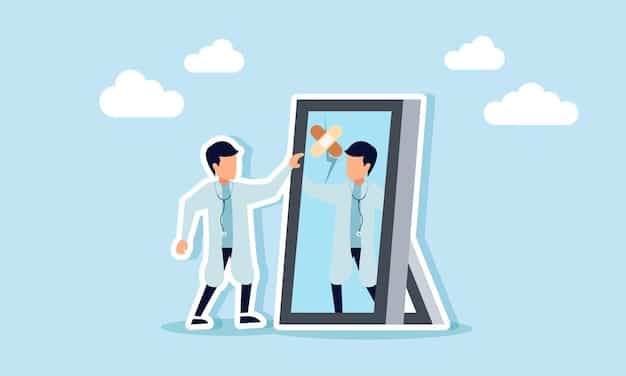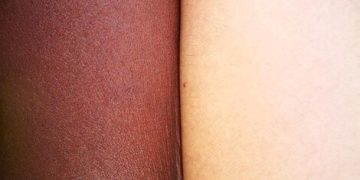The Complete Guide to Rhinoplasty: Preparation and Recovery

The Complete Guide to Preparing for and Recovering From a Rhinoplasty Procedure offers in-depth, actionable advice on every phase of nasal surgery, ensuring patients are well-informed and supported from initial consultation through complete healing.
Considering a nose job? This complete guide to preparing for and recovering from a rhinoplasty procedure provides essential information, ensuring a smooth and successful journey from consultation to complete healing.
Understanding Rhinoplasty: An Overview
Rhinoplasty, commonly known as a nose job, is a surgical procedure designed to reshape the nose and improve its overall appearance. Beyond aesthetics, rhinoplasty can also correct structural issues that impair breathing.
Whether you’re seeking cosmetic enhancements or functional improvements, understanding the procedure and its recovery is key. This guide offers a detailed walkthrough of what to expect.
Cosmetic vs. Functional Rhinoplasty
Cosmetic rhinoplasty focuses on altering the shape and size of the nose to enhance facial harmony. Functional rhinoplasty, on the other hand, aims to correct structural problems, such as a deviated septum, to improve breathing.
Many rhinoplasty procedures involve both cosmetic and functional elements, addressing both aesthetic concerns and underlying structural issues.
- Cosmetic Goals: Reshaping the nasal bridge, refining the tip, or altering the nostrils for aesthetic balance.
- Functional Goals: Correcting a deviated septum, repairing nasal valve collapse, or improving nasal airflow.
- Combined Procedures: Addressing both aesthetic and functional concerns in a single surgical session.
Ultimately, the choice between cosmetic or functional rhinoplasty, or a combination of both, depends on the individual’s needs and goals.
Initial Consultation: What to Expect
The initial consultation is a critical step in the rhinoplasty process. It’s your opportunity to discuss your goals, address your concerns, and determine if rhinoplasty is the right choice for you.
Preparing for this consultation can help you make informed decisions and feel confident moving forward.

Discussing Your Goals and Expectations
Clearly articulating your goals and expectations is vital. Bring photos or examples of nose shapes you admire, but understand that your surgeon will consider your unique facial structure and recommend realistic changes.
Be open and honest about your desired outcomes, and listen carefully to your surgeon’s assessment and recommendations.
Medical Evaluation and Assessment
Your surgeon will conduct a thorough medical evaluation to assess your overall health and identify any potential risks or contraindications. This may include a physical examination, review of your medical history, and possibly imaging tests.
This assessment helps ensure that you are a suitable candidate for rhinoplasty and minimizes the risk of complications.
- Medical History: Providing a complete overview of past and present medical conditions, allergies, and medications.
- Physical Examination: Assessing the structure of your nose, skin thickness, and overall facial anatomy.
- Imaging Tests: Using X-rays or CT scans to evaluate the underlying bone and cartilage structure.
At the end of the initial consultation, you should have a clear understanding of the proposed surgical plan, including potential risks, benefits, and expected outcomes.
Pre-Operative Preparations: A Detailed Checklist
Proper pre-operative preparation is essential for a smooth surgery and optimal recovery. Following your surgeon’s instructions carefully can minimize risks and ensure the best possible results.
This checklist outlines key steps to take in the weeks leading up to your rhinoplasty procedure.
Medical Clearances and Tests
Your surgeon may require specific medical clearances or tests, such as blood tests, an EKG, or a chest X-ray, to ensure you are healthy enough for surgery. Complete these requirements promptly.
These tests help identify any underlying health issues that could affect the safety of the procedure.
Medication Adjustments and Restrictions
Certain medications, such as aspirin, ibuprofen, and blood thinners, can increase the risk of bleeding during and after surgery. Your surgeon will advise you on which medications to avoid and when to stop taking them.
Always inform your surgeon of all medications, supplements, and herbal remedies you are taking.
- Aspirin and NSAIDs: Stop taking these medications at least two weeks before surgery.
- Blood Thinners: Consult with your doctor to safely manage blood-thinning medications.
- Herbal Supplements: Discontinue use of herbal supplements, as some can interfere with anesthesia or increase bleeding risk.
Adhering to these medication guidelines is crucial for minimizing complications and ensuring a safe surgical experience.
The Rhinoplasty Procedure: What Happens on Surgery Day
Understanding what to expect on the day of your rhinoplasty procedure can help alleviate anxiety and ensure a smooth and comfortable experience.
From arrival at the surgical center to the initial post-operative care, here’s a detailed overview.
Arrival and Pre-Surgical Preparations
Upon arrival at the surgical center, you will be greeted by the nursing staff and taken to a pre-operative area. You will change into a surgical gown, and your vital signs will be monitored.
Your surgeon will meet with you to review the surgical plan and answer any last-minute questions.
Anesthesia Options and Administration
Rhinoplasty can be performed under local anesthesia with sedation or general anesthesia, depending on the complexity of the procedure and the patient’s preference. Your anesthesiologist will discuss the options with you and administer the chosen anesthesia.
The goal is to ensure you are comfortable and pain-free throughout the surgery.
- Local Anesthesia: Numbs the nose and surrounding area, often combined with oral or intravenous sedation.
- General Anesthesia: Induces a state of unconsciousness, requiring the placement of a breathing tube.
- Monitoring: Continuous monitoring of vital signs, including heart rate, blood pressure, and oxygen levels.
Throughout the surgery, the surgical team will prioritize your safety and comfort.
Post-Operative Care: The First Few Weeks
The first few weeks after your rhinoplasty procedure are critical for healing and achieving the desired results. Following your surgeon’s post-operative care instructions is essential.
This section provides a comprehensive guide to managing your recovery during this period.

Managing Pain and Discomfort
It’s normal to experience some pain, swelling, and bruising after rhinoplasty. Your surgeon will prescribe pain medication to help manage discomfort. Apply cold compresses to reduce swelling and bruising.
Follow your surgeon’s instructions for pain management and wound care.
Nasal Packing and Splint Care
In some cases, nasal packing may be placed inside the nose to support the tissues and control bleeding. A splint is typically applied to the outside of the nose to maintain its shape during the initial healing phase.
Follow your surgeon’s instructions for caring for the nasal packing and splint. Avoid touching or adjusting them without guidance.
- Nasal Packing Removal: Your surgeon will remove the nasal packing after a few days.
- Splint Care: Keep the splint dry and avoid bumping or dislodging it.
- Cleaning: Gently clean the skin around the splint with a cotton swab and mild soap.
Proper care of the nasal packing and splint is crucial for ensuring optimal healing and maintaining the new nasal structure.
Long-Term Recovery and Results
While the initial recovery period lasts a few weeks, it can take several months, or even up to a year, to see the final results of your rhinoplasty procedure. Patience is key.
This section outlines what to expect during the long-term recovery phase and how to maintain your results.
Following Up with Your Surgeon
Regular follow-up appointments with your surgeon are essential for monitoring your progress and addressing any concerns. Attend all scheduled appointments and communicate any changes or issues you experience.
Your surgeon can provide guidance on long-term care and maintenance.
Lifestyle Adjustments for Optimal Results
Certain lifestyle adjustments can help optimize your results and maintain the appearance of your nose. Avoid activities that could potentially injure your nose, such as contact sports, for several months after surgery.
Protect your skin from sun exposure and maintain a healthy lifestyle.
- Sun Protection: Use sunscreen on your nose to prevent discoloration and maintain skin health.
- Healthy Diet: Consume a balanced diet rich in vitamins and minerals to support healing.
- Gentle Skincare: Use gentle skincare products to avoid irritation and promote skin health.
By following these guidelines, you can maximize your results and enjoy the long-term benefits of your rhinoplasty procedure.
| Key Point | Brief Description |
|---|---|
| 🩺 Consultation | Discuss goals and evaluate medical suitability for rhinoplasty. |
| 💊 Pre-Op Prep | Adjust medications, get medical clearances, and follow surgeon’s advice. |
| 🤕 Post-Op Care | Manage pain, care for splint, and attend follow-up appointments. |
| ⏳ Long-Term Results | Follow a healthy lifestyle and protect the nose for lasting results. |
Frequently Asked Questions
The duration of rhinoplasty surgery varies depending on the complexity of the procedure, typically ranging from 1.5 to 3 hours. Factors include the extent of reshaping and whether it’s cosmetic or functional.
Most patients can return to work within 1-2 weeks after rhinoplasty, depending on the nature of their job and the extent of swelling and bruising. Strenuous activities should be avoided for several weeks longer.
Potential risks include bleeding, infection, adverse reaction to anesthesia, nasal asymmetry, breathing difficulties, numbness, skin discoloration, and the need for revision surgery. It is important to discuss these with your surgeon.
The average cost of rhinoplasty in the US ranges from $5,000 to $15,000, depending on the surgeon’s experience, the complexity of the procedure, and geographic location. This often doesn’t include anesthesia, operating room facilities, or other related expenses.
Yes, functional rhinoplasty can improve breathing issues by correcting structural problems such as a deviated septum or nasal valve collapse. Many patients experience significant improvements in nasal airflow and overall breathing ability.
Conclusion
Undergoing a rhinoplasty procedure is a significant decision that requires careful consideration and thorough preparation. From the initial consultation to the long-term recovery, understanding each step of the process ensures a smoother experience and helps achieve the desired results, improving both aesthetics and function.





